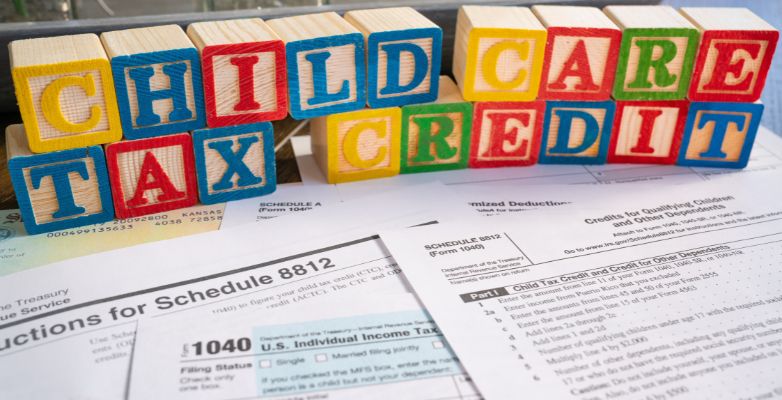Schedule 8812 (Form 1040) serves as a tool for Americans to figure out if they qualify for the Child Tax Credit. When you want to take advantage of child tax credits, you can utilize Schedule 8812 (Form 1040) to make a claim. With this form, you can determine the credits you’re eligible for, assess any tax you might owe to the IRS, and estimate the amount you could receive.
Tax credits are essentially benefits given to eligible taxpayers to help reduce the amount of taxes they owe to the government. Some of these credits are even refundable. If a credit is refundable, it means that if the credit amount exceeds the tax owed, the individual can receive a tax refund for the difference.
Table of Content
Changes to the Child Tax Credit
Starting in 2018, the Child Tax Credit saw a significant increase, doubling to $2,000 per qualifying child (from $1,000 per child previously). On top of this, through the Additional Child Tax Credit, you can potentially claim up to an extra $1,400.
In 2023, the federal government won’t be offering advanced child tax credit payments. These payments were initially designed to assist families in coping with increased expenses and financial challenges caused by the COVID-19 pandemic.
However, even though advanced child tax credit payments won’t be available in 2023, you might still be eligible for a one-time tax refund. After you’ve filled out the form, you can determine the amount of your child tax credit, and there’s no need for a separate filing to claim this tax credit.
Qualifications for Dependent Children
Before you can claim the Additional Child Tax Credit using Schedule 8812 (Form 1040), you need to ensure your dependents meet specific requirements. A qualifying child can be your son, daughter, blood or step-sibling, stepchild, foster child, or the descendant of any of these relatives. It’s important to note that the child must not turn 17 before the end of the tax year, must not provide more than half of their own financial support, and should have lived with you for over half of the tax year.
For more details on who qualifies as a dependent child for this credit, you can refer to the IRS website. In addition to meeting these requirements, you’ll also need to claim the child as a dependent on your tax return to be eligible for the Additional Child Tax Credit.
General Instructions
Taxpayer Identification Number Requirements:
You need a Taxpayer Identification Number (TIN) Before your Return’s Due Date
- If you or your spouse (when filing jointly) don’t have a Social Security Number (SSN) or an Individual Taxpayer Identification Number (ITIN) issued on or before the due date of your 2023 return, including extensions, you won’t be able to claim the Child Tax Credit (CTC), Other Dependent Credit (ODC), or Additional Child Tax Credit (ACTC) on either your original or an amended 2023 return.
- If you apply for an ITIN before the due date of your 2023 return, including extensions, and the IRS issues you an ITIN, they’ll consider it as if it was issued on or before the due date of your return.
Each Qualifying Child You Use for CTC or ACTC Must Have the Required SSN
- To claim the CTC or ACTC, every qualifying child must have a valid SSN issued before the due date of your 2023 return, including extensions, and it should be suitable for employment purposes.
- If your qualifying child was born and passed away in 2023 and lacks an SSN, you should include a copy of the child’s birth certificate, death certificate, or hospital records as proof that the child was born alive.
- If your qualifying child doesn’t possess the required SSN but holds another type of taxpayer identification number issued before the due date of your 2023 return, including extensions, you may still qualify to claim the ODC for that child.
Each Dependent You Use for the ODC Must Have a TIN by the Due Date of Your Return
- If you have a dependent who doesn’t have an SSN, ITIN, or ATIN issued on or before the due date of your 2023 return (including extensions), you can’t use that dependent to claim the ODC on your original or an amended 2023 return.
- If you apply for an ITIN or ATIN for the dependent on or before the due date of your 2023 return (including extensions), and the IRS issues the ITIN or ATIN because of the application, the IRS will treat it as if it was issued on or before the due date of your return.
Improper Claims
- If you mistakenly claim the CTC, ACTC, or ODC, and it’s later found that your error was because you recklessly or intentionally disregarded the rules, you won’t be allowed to claim any of these credits for 2 years, even if you are otherwise eligible.
- If it’s determined that your error was due to fraud, you won’t be allowed to claim any of these credits for 10 years, and you may also face penalties.
Form 8862 May Be Required
If your CTC (refundable or nonrefundable, depending on the tax year), ACTC, or ODC for a year after 2015 was denied or reduced for any reason other than a math or clerical error, you must attach Form 8862 to your tax return to claim the CTC, ACTC, or ODC unless an exception applies. For more information, including whether an exception applies, see Form 8862, Information To Claim Certain Credits After Disallowance, and its instructions.
How to File Schedule 8812 for the Year 2023?
Filing Schedule 8812 (Form 1040) is a straightforward process, and there’s no need for a separate application to claim this credit. You can easily access the IRS form at www.irs.gov/Schedule8812. Be sure to carefully follow the instructions provided in IRS Schedule 8812.
Here’s a simple step-by-step guide:
- Download the IRS Form from the IRS website and a copy of the form.
- Go through the Form 8812 instructions to understand how to complete the form correctly.
- Fill out the form according to the Schedule 8812 instructions. You’ll use the information from Form 1040 to calculate your credit amount.
- you’ve filled out Schedule 8812, attach it to your regular tax return (Form 1040).
For the 2023 tax season, Schedule 8812 consists of three parts:
- Part I: If you’re claiming the primary Child Tax Credit, complete Part I using the details from your Form 1040. This is where you calculate your credit amount.
- Part II-A: If you qualify for the Additional Child Tax Credit, this is the section to complete.
- Part II-B: If you have three or more qualifying children or are a resident of Puerto Rico, you’ll need to fill out Part II-B.
- Part II-C: Finally, tally up any additional credits and enter this total on your Form 1040.
Part I: Child Tax Credit and Credit for Other Dependents (All Filers):
- Line 4: Count how many times you checked the “child tax credit” boxes in column (4) of the Dependents section on Form 1040 or 1040-SR. Write that number on line 4.
- Line 6: Count how many times you checked the “credit for other dependents” boxes in column (4) of the Dependents section on Form 1040 or 1040-SR. Write that number on line 6.
- Line 13: Put the amount from Credit Limit Worksheet A on this line. When you do the Credit Limit Worksheet A, it might tell you to do Credit Limit Worksheet B if you meet certain conditions. Only do Credit Limit Worksheet B if all of these are true:
- You are claiming one or more of these credits:
- Mortgage interest credit, Form 8396.
- Adoption credit, Form 8839.
- Residential clean energy credit, Form 5695, Part I.
- District of Columbia first-time homebuyer credit, Form 8859.
- You are not using Form 2555.
- Line 4 of Schedule 8812 has a number greater than zero.
Part II-A: Additional Child Tax Credit for All Filers:
If the number on line 12 is bigger than line 14, you might be able to get the additional child tax credit. First, complete your Form 1040, 1040-SR, or 1040-NR up to line 27 (also complete Schedule 3, line 11) before doing Part II-A.
In the Case of Bona Fide Residents of Puerto Rico:
If you lived in Puerto Rico and were a true resident there in 2023, you might be qualified to claim the Additional Child Tax Credit (ACTC) if you had a qualifying child. To claim the ACTC, you can use Part II of Form 1040-SS, known as the U.S. Self-Employment Tax Return. This is an option if you’re not required to use Form 1040 or 1040-SR.
To determine your eligibility and calculate the ACTC using Schedule 8812, follow these steps in Part II-A and II-B:
- Line 18a: Include only the earned income that you reported on Form 1040 or 1040-SR. Don’t include the income you earned in Puerto Rico, as it’s not subject to U.S. tax due to your genuine residency in Puerto Rico.
- Line 21: Combine all the social security, Medicare, and Additional Medicare taxes that were withheld, including those withheld by employers in Puerto Rico. These details can be found on Puerto Rico Form(s) 499R-2/W-2PR.
To be recognized as a bona fide resident of Puerto Rico, consider these factors for the year 2023:
- You met the presence test, indicating that you spent a significant amount of time in Puerto Rico.
- Your primary tax residence was in Puerto Rico and not outside of it.
- Your connection to Puerto Rico was stronger than any connection to the United States or any other foreign country.
These criteria determine whether you can be considered a bona fide resident of Puerto Rico, and therefore, eligible to claim the ACTC. Remember that this credit can provide valuable financial support, so understanding your eligibility and following the proper steps is crucial.
- Line 15: Mark this box if you don’t want to get the additional child tax credit. If you check this box, skip Parts II-A and II-B, and write -0- on line 27.
- Line 18a: If you earned money from self-employment and used the optional method to calculate it, use the Earned Income Worksheet to figure out what to write online 18a. Otherwise, most other people can use the Earned Income Chart to figure out what to write online 18a.
- Line 18b: Write on line 18b the total amount of non-taxable combat pay you got in 2023. You (and your spouse if you’re filing together) should have received this amount either on line 1i of Form 1040 or 1040-SR, or it should be shown in Form W-2, box 12, with code Q.
- Part II-B: Certain Filers Who Have Three or More Qualifying Children and Are Bona Fide Residents of Puerto Rico:
- Line 21: If you are doing Part II-B and your employer took out or paid Additional Medicare Tax or tier 1 RRTA tax, use the Additional Medicare Tax and RRTA Tax Worksheet to figure out what to write on line 21.
Summing Up
In conclusion, navigating IRS Form 8812 and its associated schedules for the year 2023 can be complex. It involves several steps and calculations, particularly if you’re claiming tax credits related to children and dependents. If you ever find yourself unsure or overwhelmed by the process, don’t hesitate to seek assistance. Whether it’s from a tax professional, IRS guidance, or reputable tax software, help is available to ensure you complete these forms accurately and maximize the tax benefits you’re entitled to. Your financial well-being is essential, and it’s perfectly okay to ask for help when needed.
Frequently Asked Questions
Do I need to complete a form for the Child Tax Credit?
No, there’s no separate application required for this program. You simply need to file your taxes following the guidelines provided on Schedule 8812 (Form 1040 or 1040 A, Child Tax Credit page). By reviewing your tax information, the IRS will determine if you qualify and will automatically enroll you for advance payments in 2021.
Who is eligible to use Schedule 8812?
To use Schedule 8812, you must meet certain criteria:
1. You should be a U.S. citizen, national, or resident.
2. The child in question must be under 17 years old by the end of the tax year.
3. The child must have lived with you for more than half of the year.
4. You must provide over half of the child’s financial support.
Is the credit calculated on Schedule 8812 nonrefundable?
Apart from the non-refundable Child Tax Credit and Credit for Other Dependents, if you have one or more qualifying children, you might also be eligible for the refundable Additional Child Tax Credit. This means you could potentially receive a refund even if you don’t owe any taxes.




